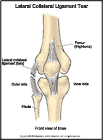
Lateral Collateral Ligament Sprain
What is lateral collateral ligament sprain?
A sprain is a joint injury that causes a stretch or tear in a ligament, a strong band of tissue connecting one bone to another. The lateral collateral ligament is located on the outer side of the knee. It attaches the thighbone (femur) to the outside bone in the lower leg (fibula).
Sprains vary from minor tears in a few fibers of ligament to complete tears of entire ligaments. Complete tears make the joint very loose and unstable.
How does it occur?
The lateral collateral ligament can be injured by a twisting motion or from a blow to the inner side of the knee.
What are the symptoms?
Symptoms may include the following:
- You have pain on the outer side of your knee.
- Your knee is swollen and tender.
- You have the feeling of your knee giving way.
- You hear or feel a pop or snap at the time of injury.
How is it diagnosed?
Your health care provider will ask how you injured your knee. He or she will examine your knee for tenderness on the outer side of your knee. He or she will gently move your knee around to see if the joint is stable and if the ligament is stretched or torn. Your provider may order x-rays or a magnetic resonance image (MRI) of your knee.
How is it treated?
Treatment may include:
- applying ice to your knee for 20 to 30 minutes every 3 to 4 hours for 2 to 3 days or until the pain and swelling go away
- elevating your knee by placing a pillow underneath it (to help reduce swelling)
- taking anti-inflammatory medication or other drugs prescribed by your health care provider
- wrapping an elastic bandage around your knee to keep the swelling from getting worse
- using crutches until you can walk without pain
- doing rehabilitation exercises
- surgery to repair a complete tear.
While you are recovering from your injury, you will need to change your sport or activity to one that does not make your condition worse. For example, you may need to swim instead of run. Your provider may give you a brace to wear if you need to participate in sports or other activities while you are recovering.
When can I return to my sport or activity?
The goal of rehabilitation is to return you to your sport or activity as soon as is safely possible. If you return too soon you may worsen your injury, which could lead to permanent damage. Everyone recovers from injury at a different rate. Return to your sport or activity will be determined by how soon your knee recovers, not by how many days or weeks it has been since your injury occurred. In general, the longer you have symptoms before you start treatment, the longer it will take to get better.
You may safely return to your sport or activity when, starting from the top of the list and progressing to the end, each of the following is true:
- Your injured knee can be fully straightened and bent without pain.
- Your knee and leg have regained normal strength compared to the uninjured knee and leg.
- Your knee is not swollen.
- You are able to jog straight ahead without limping.
- You are able to sprint straight ahead without limping.
- You are able to do 45-degree cuts.
- You are able to do 90-degree cuts.
- You are able to do 20-yard figure-of-eight runs.
- You are able to do 10-yard figure-of-eight runs.
- You are able to jump on both legs without pain and jump on the injured leg without pain.
If you feel that your knee is giving way or if you develop pain or have swelling in your knee, you should see your health care provider.
How can I prevent a lateral collateral ligament sprain?
Unfortunately, most injuries to the lateral collateral ligament occur during accidents that are not preventable. However, you may be able to avoid these injuries by having strong thigh and hamstring muscles, as well as by gently stretching your legs before and after exercising. In activities such as skiing, be sure your ski bindings are set correctly by a trained professional so that your skis will release when you fall.

